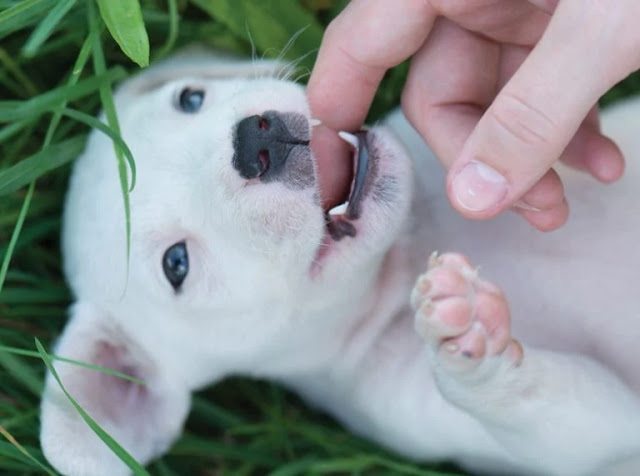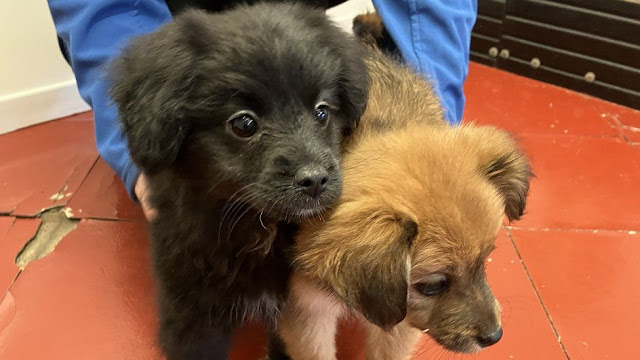what to do with puppy while at work?

It’s perfectly normal to feel anxious and guilty about leaving your puppy alone while you’re at work. Your little furry friend often feels like they can’t be left unsupervised even for a few minutes without causing chaos in the house, making a mess, or crying because they miss you. So, it’s natural to worry about how they’ll manage being alone for several hours.
It’s crucial to understand that leaving your puppy alone at home for safe intervals is neither harmful nor dangerous. In fact, it’s beneficial for young puppies to learn how to self-soothe and remain calm without their family always around.
If you’re returning to work and are anxious about what to do with your puppy, you’ve found the right resource. Continue reading to discover how long you can safely leave your puppy alone and how to ease the transition for both you and your furry friend.
How Long Can You Leave a Puppy Alone?
How long can a puppy be left on its own? The duration depends on the pup’s age, physical requirements, and emotional needs. While most healthy adult dogs can go six to eight hours without needing a bathroom break, puppies have a much shorter limit—they can only hold their bladder for about one hour per each month of their age.
For instance, a three-month-old puppy can manage around three hours. Because of this, experts generally recommend that young puppies should not be left alone for more than two to three hours at a time.
The amount of time you can leave your puppy alone also depends on their breed and personality. For instance, a high-energy husky with severe separation anxiety will require significantly more time and attention compared to a laid-back breed that barely notices your absence. Generally, however, it is recommended not to leave any dog alone for longer than four to six hours at a stretch.
Top Tips for Leaving a Puppy Home Alone While You’re at Work
Leaving a puppy by itself for extended periods can result in future behavioral issues, a wrecked house, and significant guilt on your part. Fortunately, there are numerous strategies to assist you during the puppy phase and ensure Fido remains content during your absence. Below are some of our top recommendations for handling the situation while you’re out.
1. Create a Safe Confinement Area
The last thing you need is a rambunctious puppy wreaking havoc in your home while you’re away at work. Not only could it ruin your cherished belongings (goodbye, beloved mid-century modern chair), but it might also get into hazardous items like chocolate, medications, and cleaning supplies, potentially leading to an urgent visit to the vet.
To ensure Fido’s safety, as well as the safety of your belongings, establish a secure area specifically for your pet. Crate training is an excellent method for keeping older puppies safely contained while you’re at work.
(Tip: Encourage positive associations with the crate by leaving the door open and…) placing delicious chew treats insideIf you have a young puppy or anticipate being away for more than four hours at a time, think about using a puppy pen instead. This pen will provide your puppy with a secure space to play and move around. You can also put a puppy pad in one corner to manage any accidents your dog might have while you’re at work.
2. Ease into It
If you’ve been working from home since you got your puppy, your furry friend is likely accustomed to your constant, comforting presence. Therefore, it’s crucial to ease into any changes. Begin by leaving your puppy in their playpen or crate for 10 minutes at a time. Before you step out, give your pup a tasty treat to help them associate your absence with something positive.
If your dog starts showing signs of anxiety, like whining, pacing, or chewing destructively, don’t punish them. Instead, shorten the time you’re away and gradually extend it as your puppy gets more comfortable.
3. Give Your Pup a Workout
As the saying goes, “A tired pup is a good pup.” To leave the house without your dog barking or whining at your departure, ensure they get enough exercise suitable for their age. This is particularly crucial for high-energy breeds that have plenty of excess energy to expend.
Just like people, Dogs experience a surge of positive endorphins when they engage in physical activity.Why not get your puppy’s heart racing to boost their mood? Tire them out with a brisk morning walk or a game of fetch in the backyard. (Remember, you can also engage their mind with training sessions.) By the time you head to work, your puppy will be ready to settle down for a nap.
4. Be Choosy About Chew Toys and Treats
Providing the The finest calming treats and chew toys for your dogIt’s a fantastic solution to keep your dog entertained while you’re at work. Plus, they are beneficial for your dog’s dental health as well! However, it’s crucial to ensure that dogs are not left alone with objects that might pose a choking risk.
Therefore, we suggest…using bone marrow for dogs and other nutritious, edible chew toysAs a special treat for when you return home, imagine how thrilled your puppy will be when you step through the door with a bully stick or a flavorful marrow bone!
So, what can Do you place your puppy in a crate or playpen when you’re away? Here are some recommendations:
- Hard rubber toys. Look for one that has holes or crevices, stuff it with peanut butter, and let your dog have a blast.
- Toys made of woven material with knotted ends. These toys are perfect for dogs that like varied textures. Ensure the toy is securely woven so your pup doesn’t tear it apart.
- Brain-teasing toys and engaging playthings. Puzzle toys are an enjoyable method to stimulate your dog’s mind and keep them entertained while you’re at work. They’re also great for rainy days!
5. Create a Calming Atmosphere
It’s normal for dogs to feel anxious when their owners go out. If you’re concerned that your puppy might not handle your absence well, there are a few simple steps you can take to reduce their stress and keep them calm while you’re away. One effective method is to leave an unwashed t-shirt, a blanket, or any other item that has your scent in their crate. The familiar smell will offer comfort to your pet long after you have left for work.
You might also consider using dog-appeasing pheromones (DAPs), calming supplements such as L-Theanine (make sure to get advice from your veterinarian first), and gentle instrumental music to help relax your dog. Since each dog has unique preferences, it’s important to try different methods until you discover what works best to soothe your pet.
If your dog suffers from severe separation anxiety, consider seeking assistance from a professional trainer.
6. Play Background Noise
Providing some background noise for your furry companion, whether it’s from the radio, television, or a white noise machine, is an easy and effective method to make your pet feel less isolated when you’re not home. Background noise can not only entertain your dog throughout the day but also mute external sounds that might cause anxiety.
Naturally, you’ll need to be selective about the background noise you opt for. Keep in mind that certain radio stations and TV channels feature commercials and ads with sounds that could agitate your dog (such as ringing doorbells, barking dogs, and car alarms). To avoid unintentionally increasing your dog’s stress levels, be cautious with your choices. consider streaming DOGTV and various programs that are tailored exclusively for dogs.
7. Come Home During Your Lunch Break
If you crate your dog while you’re at work, it’s important to come home at mid-day to let them out. Even grown dogs need to stretch and relieve themselves after four hours in a crate. If you’re using a puppy pen and pee pads, it’s still beneficial to check on your puppy during your lunch break. If you can’t make it home, you might ask friends or family to help out. Many dog enthusiasts will gladly volunteer for this, as it gives them a chance to spend time with a cute puppy.
If your boss has a fondness for puppies, they might be open to allowing you a flexible schedule to care for your new furry friend. It’s always worth asking! (Tip: Don’t forget to show them some adorable pictures of your pup before making your request.)
8. Hire a Professional Pet Sitter or Dog Walker
It’s always wise to have a professional pet sitter or dog walker readily available. Why is this important? Because even if your friends love dogs, they might not always be able to assist with your pet. By arranging for a dog walker or pet sitter ahead of time, you’ll have someone reliable to call when you’re delayed in traffic or caught in an unexpectedly long meeting.
The main thing is to find a pet sitter you can trust. If you know friends or family with dogs, consider asking them for recommendations. You can also… Look for a pet sitter who has professional credentials.from organizations like the National Association of Professional Pet Sitters (NAPPS).
9. Consider Doggy Daycare
Another excellent choice for busy pet owners is doggy daycare. Similar to child daycare, these pet-friendly centers take care of your dog throughout the day, ensuring all their needs are met while you focus on your work tasks like Excel sheets or report writing. Besides offering exercise, doggy daycare is a fantastic way to further develop your dog’s social skills. However, it’s important to note that not all doggy daycare centers are the same.
It’s crucial to research and select a facility that prioritizes transparency and comfort. Also, keep in mind that not every dog is suited for daycare. Ensure your dog is already well-socialized and free of any behavioral issues or bad habits that could be aggravated in a daycare setting.
10. Install a Pet Camera
If you’re someone who constantly worries about your pet when you’re not around, consider installing a pet camera in your home. Monitoring your puppy and seeing that they are happy can significantly ease your anxiety.
Pet cameras can be quite affordable, with some available for under $40. However, if you desire the ability to interact with your pet and give them treats remotely, you might want to invest in a more advanced pet camera with additional features. The peace of mind it offers could be well worth the investment!
Don’t Forget to Reward Your Puppy Upon Your Arrival
When you arrive home from work, your puppy is likely to be thrilled to see you. Hold off on greeting them until they’ve settled down. After your puppy has calmed, give them an all-natural chew treat and shower them with lots of attention. Since your pup adds so much happiness to your life, it’s only fitting to reciprocate!
what to do with puppy while at work
1) Take a look at your work situation
Before creating a game plan for your new puppy, it’s essential to evaluate your work situation. Consider asking yourself these questions before introducing a puppy into your home.
- Do you follow a set schedule or a more adaptable one?
- Do you typically work from home, or do you usually commute to the office?
- How much time does your commute take when you go to the office?
- Would you be able to take some time off if necessary for your puppy?
- Can you reduce your hours or arrange for someone else to take over your shifts when necessary?
- Do you live alone or with other people?
Consider your options to determine if you can allocate more time at home with your new puppy. It might be helpful to develop a strategy that avoids leaving your puppy alone abruptly. Spend the initial days together and gradually introduce periods of solitude. Start with brief intervals, such as a few minutes, then extend to an hour, and eventually longer durations.
Avoid immediately leaving your puppy alone for several hours. Ideally, bring your puppy home over a weekend to allow for some initial bonding time. Should you be unable to take time off work, arrange for a friend or family member to stay with your puppy initially, helping them adjust to being alone for longer periods.
2) Create a space for your puppy
One of the most crucial tasks for a new puppy owner is to ensure that their puppy feels safe and secure. This begins with establishing a dedicated space for the puppy, ideally around 6×4 feet. Many individuals choose to use a puppy pen You can designate a spare bedroom or even a bathroom for your puppy. It’s important to start with a small, secure area and gradually increase their space.
Ensure the area includes essential pet supplies like a comfortable bed, some toys, and something with your scent, such as old clothing. Puppies usually prefer den-like, cozy spaces, so a smaller, warm area is ideal. Creating a proper space for your pup can also help with potty training, as dogs typically avoid relieving themselves near their sleeping or living areas.
3) Leaving your puppy alone during the day
The common guideline for leaving a puppy alone during the day is one hour for each month of age. For example, a two-month-old puppy usually can’t hold its bladder for more than two hours, a three-month-old for three hours, and so on. While this is a general rule, it serves as a useful starting point for creating a schedule that accommodates your new puppy.
Puppy pads are often used as a backup by new puppy owners, and placing some in your puppy’s area can be helpful. Just don’t be too surprised if your puppy views them as a… fun thing to shred rather than a place to relieve himself!
3) Monitor your puppy
Make sure you can easily check on your dog, even if they are old enough to be left alone. What if your dog experiences separation anxiety, starts barking excessively, or gets into trouble while you’re not there? You can use various monitoring devices such as a home security camera, a baby monitor, or a camera specifically designed for pets.
Furbo Dog Camera is an interactive device that allows you to see, communicate, and play with your dog from a distance using your mobile phone. With its two-way communication feature, you can talk to your dog whenever needed to ease separation anxiety or correct unwanted behaviors. The free app lets you check on your dog at any time, day or night.
HD, night vision camera It lets you see clearly and includes a dog alert notification system that notifies you whenever your dog barks, allowing you to monitor barking and be alerted if your pup is in distress. You can take photos and videos to discuss specific behaviors with a trainer or vet.
The free app also lets you control the video, photos, and treat dispenser, so you can use these features as long as you have access to your phone. Furbo emits a clicking sound before releasing a treat, making it perfect for clicker training.
4) Keep your pup busy
When left alone, a bored puppy can quickly become anxious, particularly because you, their primary source of amusement, won’t be there. To keep your puppy engaged, provide puzzles, toys, and other activities. An excellent option is a frozen treat that requires effort to unlock a snack, keeping them occupied for hours.
You might also introduce a special treat that your puppy only gets when you’re away, helping them associate your absence with something positive. Explore local pet stores or online dog shops for interactive toys that will entertain your pup!
5) Leave quietly
When you need to leave your dog home alone during the day, it’s advisable to make your departure low-key and undramatic. For effective house training, leave the house calmly without excessive displays of affection. Although this can be difficult, minimizing the focus on your comings and goings will help your puppy be happier and more well-adjusted.
It’s essential to develop this habit early on, as it not only reduces the chances of accidents but also helps to prevent separation anxiety, a primary cause of behavioral issues in dogs.
6) Give your puppy attention and a chance to cut loose when you get home
What you do at home is just as crucial as what you do before and during your workday to ensure your furry family member is comfortable being left alone. When you return home, greet your pup warmly, take them for a walk, and shower them with praise. Give them affection and make sure to spend quality time with them.
You can also use your time at home to train commands like “quiet” so your pup is prepared to be calm when you’re not around. Providing extra attention and love can help compensate for time spent alone. Therefore, even if you bring work home, it’s important to allocate some time for both training and fun. Additionally, ensure your puppy gets plenty of social interaction.
Time spent with other dogs and visits to dog parks can help your dog adjust better to being alone. A dog that isn’t well-socialized and spends too much time alone may be more prone to excessive barking and anxiety. So, make sure your fur baby has a vibrant social life!
Do you understand everything? Raising a puppy can be a delightful yet challenging experience for novice dog owners, particularly those with full-time jobs. The key is to remain patient and dedicate time to training your pup. With proper training and positive reinforcement, your puppy will smoothly adapt to its new environment.
Don’t get discouraged if your puppy takes longer to settle in compared to others; each dog is unique. Ultimately, there are no dogs that can’t be trained, only humans who haven’t learned how to train them!
Greetings from the Petworled website management, we wish you success and see you in another article on our website.















